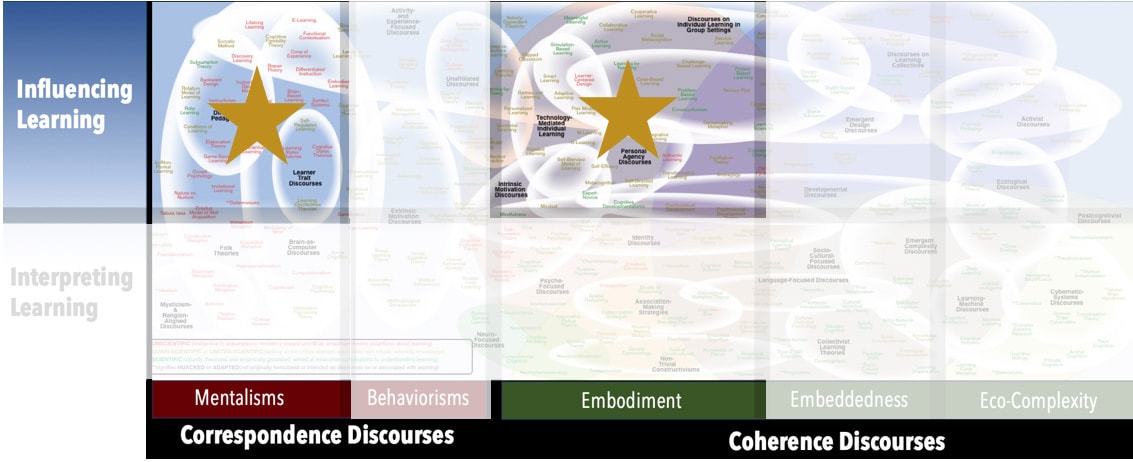AKA
Blended Model
Hybrid Learning
Mixed eLearning
Mixed-Mode Learning
Technology-Enhanced Learning (TEL)
Technology-Mediated Instruction
Web-Enhanced Instruction
Focus
Combining face-to-face and technology-mediated formats to improve educationPrincipal Metaphors
Blended Learning is not explicit about or aligned with any particular theory of learning – and, consequently, vocabulary used to characterize learning is not consistent. Most often, references and are suggestive of Folk Theories. The following are typical:- Knowledge is … material (objects)
- Knowing is … mastery of knowledge
- Learner is … an accumulator
- Learning is … acquiring
- Teaching is … delivery
Originated
1960sSynopsis
Blended Learning is an approach to student engagement that combines familiar face-to-face approaches with technology-mediated experiences. Discussions of Blended Learning began in the 1950s, and so conceptions and evolved and diverged as new technologies have been incorporated, as principles have been applied to more topics and across more levels, and as learner self-determination has risen as an educational priority. Subdiscourses to Blended Learning include:- HyFlex Learning (Ben Malczyk, Dawn Mollenkopf, 2010s) – a portmanteaux of Hybrid Learning (a.k.a. Blended Learning) and Flexible Learning (see Choice Learning). HyFlex Learning is a type of Blended Learning in which participants are afforded choice over some elements of how, when, and where their learning happens.
- In-Person Learning – any form of learning engagement that happens in person. The term is a retronym, coined after communication and information technologies made it possible to take part in a learning community asynchronously and/or at a distance.
- Synchronous Learning (Real-Time Learning; Sync Learning) – a general term that can be applied to any type of formal education through which learning is intended to happen at the same time, but not in the same place.
- Sync Teaching (Second Screen Learning) – a type of Synchronous Learning in which teachers and learners are precisely synchronized on content – although they continue to have levels of flexibility and choice around matters of depth of engagement, extensions to content, and personal learning strategies/structures.
- Mixed Reality Learning (Thomas Winkler, 2000s) – a rapidly evolving construct that initially brought together Situated Learning and E-Learning in a model that considered both physical and digital settings for learning. With advances in immersive technologies, possibilities are emerging for experiences that were previously out of reach.
- Seamless Learning – a phrase that most often refers to using digital technologies to enable learning in any location or at any time. It has also been used as a bridging notion that can be applied to almost any boundary (e.g., between learning tasks, or across disciplines) or dyad/dualism/dichotomy (e.g., formal/informal, individual/collective, in-school/outside-of-school, face-to-face/virtual, or private/public) encountered in the world of formal education.
Commentary
With the proliferation of technologies, Blended Learning has become a ubiquitous cultural reality, but discussions of and research on it tend to constrain themselves to the contexts and intentions of formal schooling. Other, perhaps-more-current perspectives such as M-Learning have stepped into the gap.Authors and/or Prominent Influences
DiffuseStatus as a Theory of Learning
Blended Learning is not a theory of learning.Status as a Theory of Teaching
Blended Learning is a perspective on influencing learning, but it is not a theory of teaching. Indeed, for the most part, it uncritically embraces transmission-models of pedagogy in its ongoing considerations of “delivery” modes.Status as a Scientific Theory
Research on Blended Learning is complicated by rapid evolutions of technology, shifting educational emphases, and consequent divergences in meaning of the phrase. That said, studies over the past few decades have fairly consistently shown that various formats of Blended Learning contribute to higher achievement and improved engagement when contrasted with fully face-to-face or fully technology-meditated experiences. However, because proponents do not appear to be at all attentive to the metaphors and other theoretical commitments that drive the discourse, Blended Learning cannot be described as a scientific theory according to our criteria.Subdiscourses:
- HyFlex Learning
- In-Person Learning
- Mixed Reality Learning
- Seamless Learning
- Sync Teaching (Second Screen Learning)
- Synchronous Learning (Real-Time Learning; Sync Learning)
Map Location

Please cite this article as:
Davis, B., & Francis, K. (2023). “Blended Learning” in Discourses on Learning in Education. https://learningdiscourses.com.
⇦ Back to Map
⇦ Back to List
